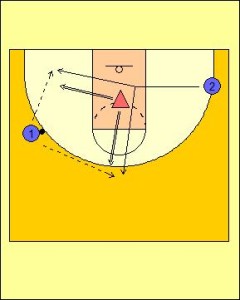Bump the Cutter Drill
The Bump the Cutter Drill is a great activity for focusing on the defence of stopping cutters gaining good positioning around the keyway. For the offense the focus is on cutting for the ball and for the defence focuses on denying easy reception in an advantageous position. The Bump the Cutter Drill is fantastic for helping players overcome their challenges whether on defence or offense.

The drill starts with an offensive player (One) foul line extended with the ball.
Another offensive player (Two) starts on the opposite side of the floor. This player looks to cut into the keyway and then flash into a receiver spot for the pass.
A defender is positioned on the split line in front of the basket. It is this defenders task to bump the cutter and deny the offensive player from receiving a pass inside the keyway or in a favourable high percentage scoring position.
The defender should look to always maintain their position between the passer and cutter while within the keyway.
Initially, the defender will be in an open stance maintaining vision of both the passer and cutter. The defender must initiate contact with the cutter at the split line and then “jockey” the offensive player away from any keyway receiver spots.
The defender when initiating the contact to stop the cutter should use an arm bar and not underestimate the force needed to stop the offensive player’s momentum. Too much impact however will result in a defensive foul so there must be some initial mistakes made to ensure the right amount of strength is applied.
The opposite arm to that of the contact, should move then into a defending position with the arm out-stretched and hand into the passing lane between both offensive players. The defenders stance should now be closed with their back towards the passer and their feet position both high and low of the offensive player’s feet. This wide stance will help with balance and taking up space within the keyway.
The passer should initially be looking to focus on making the right decision in regards to when to pass and when to just hold the ball without trying to force the pass. However, once the Bump the Cutter Drill has been performed a few times the passer can be allowed to dribble once or twice towards the basket simulating a drive. In this instance, the defender will react as though helping in defence before retreating back to the split line to commence the main purpose of the drill, which is defending the cutter.
The cutter can use a number of different techniques to create the space needed to receive a pass. Fundamentals such as creating a lead, change of direction and change of pace or employing a spin should all be attempted to help the offensive player develop a wide range of options for breaking down their defender.
In the Bump the Cutter Drill the offensive player is trying to receive the pass as close as possible to the basket and in a good scoring position so they can attack as quickly as possible.
Once the offensive cutter receives the pass the dill becomes “Live”.
Variation
An option to increase the difficulty for the offense is to limit the number of dribbles the player has once receiving the pass. Additionally, this same principle can also be applied to the types of shots the offensive player is allowed to use in taking a shot.
A very effective way to increase the pressure on the offense is to place a time limit upon the player’s possession once they have the ball. For example, a count of three might be called out by a coach once the offensive player receives the pass. This is a very effective strategy in helping players develop an offensive awareness to create and finish scoring opportunities in an effective and efficient manner.
To progress the challenge of this drill a defender can be added to the passer. This defender may only move to defend the passer and not help with the cutter in the first instance of the variation of the drill.
To further advance the complexity of the drill add additional players into the scenario. One instance might include adding another offensive and defensive player, but in the role of an interior position around the keyway. This will allow tactical elements such as screening and defending the post to be included into the Bump the Cutter Drill.
The Bump the Cutter Drill has both an offensive and defensive focus and both players should be coached evenly within the drills progression. One simple strategy to help with this is to allocate a coach to the instruction of the offensive players and another coach for the feedback/direction of the defensive player.








Leave a Reply